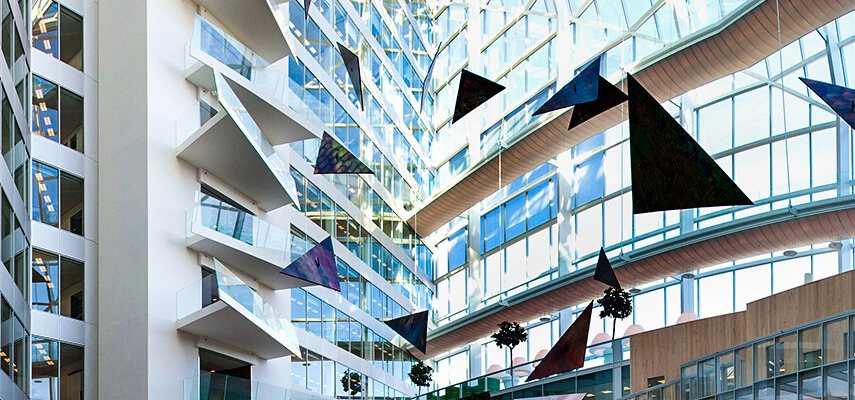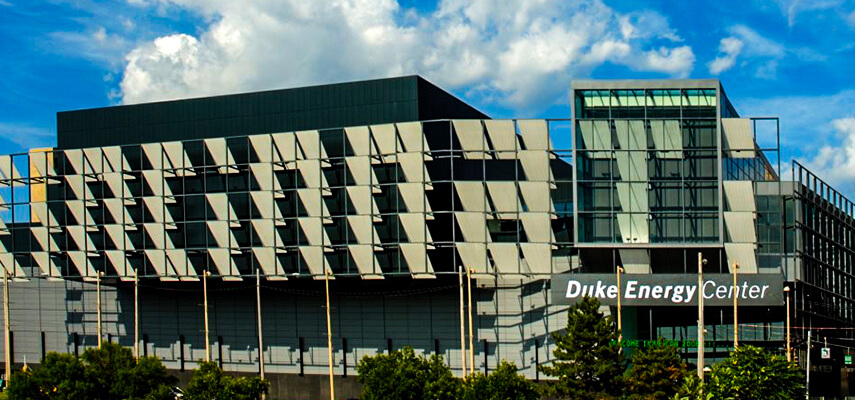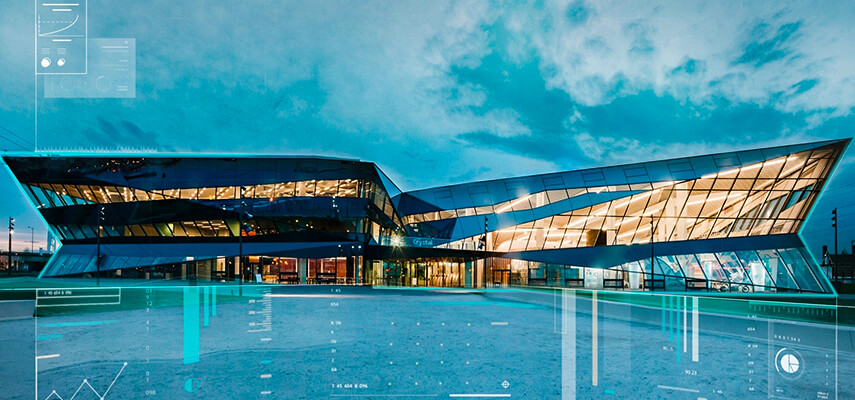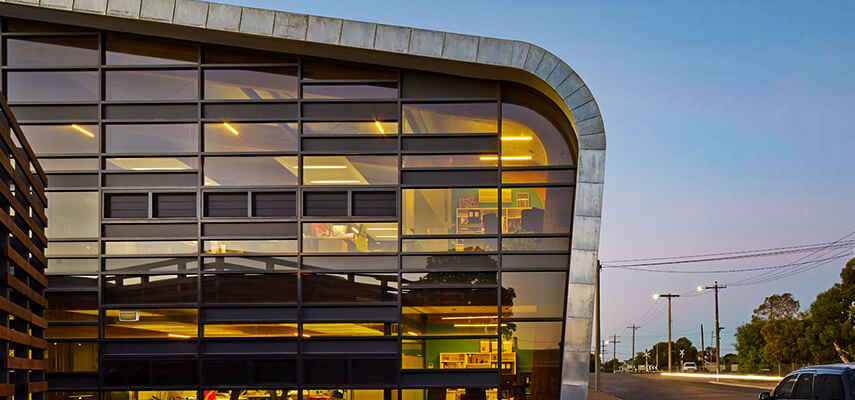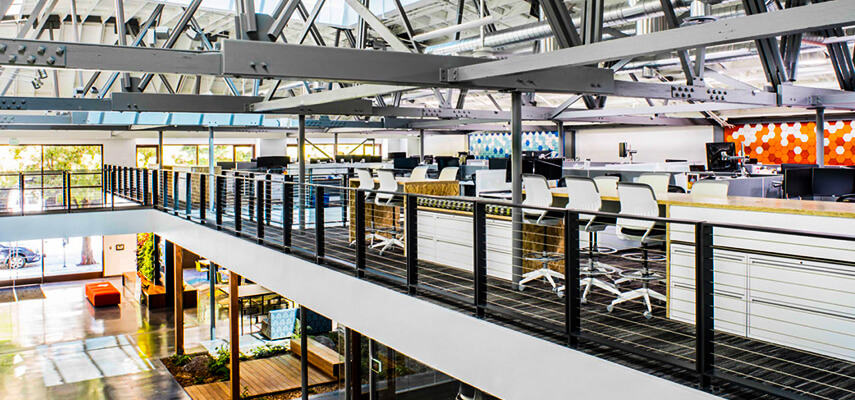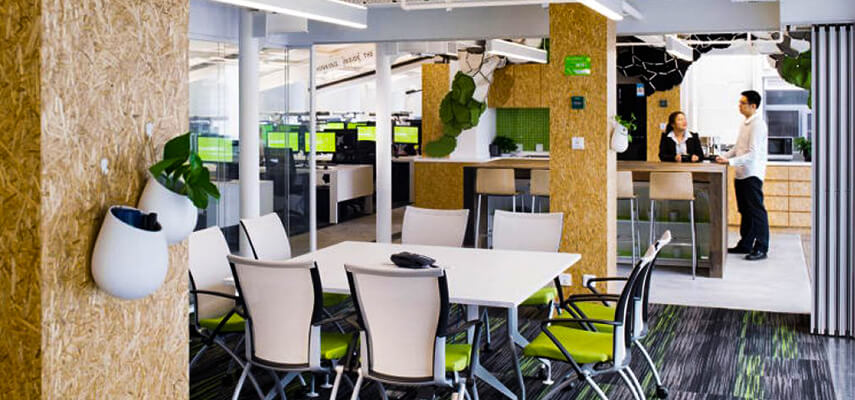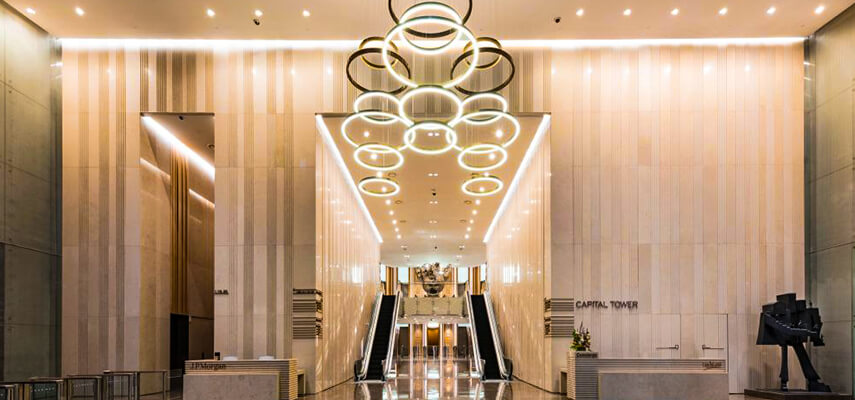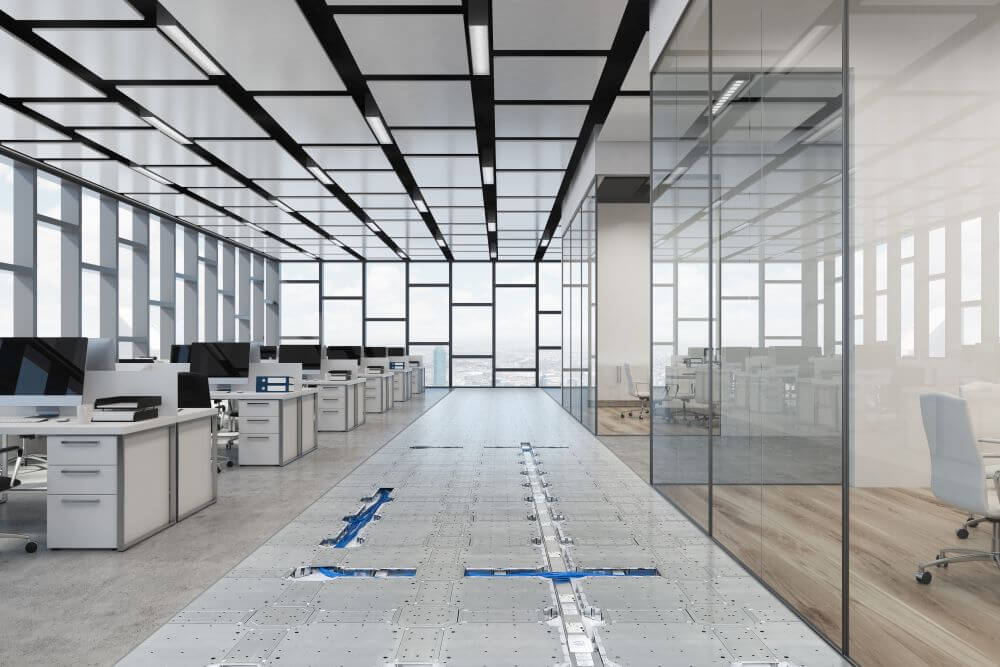Smart Buildings 101
Introducing smart buildings, including features and benefits of smart building environments, with 7 examples of smart buildings and their unique functions.
Need support for your project?
Call to speak to an advisor.
Call Now No longer are businesses bound by traditional borders, such as office cubicles, conference rooms, and executive suites; today’s businesses thrive best when unbound by rigid, old-fashioned building practices, freeing imagination and potentialities for businesses and key performers within the organization. And smart buildings are the best and most powerful way to make those leaps while continuing to revolutionize the built landscape.
It was a logical, albeit large, leap from smart devices to smart buildings. Now that this concept is gaining traction, the focus is positioning businesses to leverage their data and workforce to attain higher goals and surpass past performances.
Need support for your project?
Call to speak to an advisor.
What are Smart Buildings?

A smart building is a building that shares information or data between systems in order to optimize their overall performance. Automated processes such as heating, cooling, ventilation, and lighting become more efficient and cost-effective through data sharing. Sensors track occupancy levels and power down systems to reduce energy consumption when areas are vacant.
The journey toward greater connectivity can begin with small steps. Connected buildings are not an all-or-nothing proposition. Small changes, such as adding sensors to LED lighting systems, can reap positive outcomes.
Like most technologies, the smart building will continue to evolve. There is no one-size-fits-all. Intelligent buildings can vary in scope, including:
- Small office spaces of 100 square feet to accommodate a sole proprietor
- Sprawling complexes spanning multiple city blocks
- An extensive network operating in different time zones and loosely-connected locations
Such spaces can become smart buildings in their own right.
Smart Spaces Make Productivity Easier
In a connected space, better management of resources becomes easier. And though controlling expenses may have been the initial driver, it is better efficiencies, asset management, space utilization, and especially an overall improved experience in the building for the occupants and cost efficiencies for the operation that are proving the worth of smart buildings.
The key to successfully operating in smart buildings is utilizing technology to enhance and aid facility functions and improve the working environment while developing better management of expenses. For instance, a connected workspace efficiently heats and cools space. Sensors detect when areas are unoccupied, powering systems like LED Lighting and HVAC down.
Sensors identify the traffic flow within an operation. They can detect patterns of higher occupancy. That makes it easier for workers needing quiet to find spaces to support and preserve mental focus. This type of customization, in turn, encourages and improves positive and productive behaviors.
Lunch and other breaks are more effective by simply scanning and informing everyone of the activity levels in cafeterias and break rooms. This way, staff can quickly glance and get a visual picture showing how busy and crowded those spaces are at any given time and adjust their procedures and schedules accordingly.
It’s not just internal staff benefiting from smart buildings and their burgeoning technologies. A great example of better serving customers would be a hotel that can notify their guests of the activity and crowd levels at various amenities within the property (such as gyms, pools, tennis courts, and other public areas and attractions). Additionally, the same guests will be better served by hotel staff as their needs and wants are clearly outlined and highlighted by analyzing past behaviors and customer actions through smart data collection.
Perhaps the long-term sustainability factor is where the greater value of smart systems within a commercial building may be found. Over time, regular and consistent data collection may reveal customer behaviors and patterns, opening new avenues of opportunity and revenue for existing operations. All too often, businesses narrow their focus to current trends. This approach can result in overlooking new potential revenue streams or attractions which bring in new customers. By applying intelligent data collection and analysis within the very fabric and nervous system of smart buildings, unexpected insights can be uncovered. New products or services can emerge that better answer changing customer needs and demands.
The Rise of Smart Building Technology

Commercial buildings do not attain smart building status overnight. Rather, connected processes evolve as management and tenants become familiar with the use and benefit of these building technologies. What makes them so significant and central to business operations is the usability into the future. Cross-platform visibility of building systems takes the pressure off facilities teams and eliminates human error. Expect to see continued growth and integration in many aspects of smart buildings, including the key elements discussed below.
Analytics and Data
Forward-looking, businesses need not only use smart technology to collect data, but also to leverage the process to refine the ability to manage data at each phase of the process (collection, organization, analysis, and use). Further, data collection once focused entirely on consumer behaviors. Now due to smart building capabilities for broader data collection, insights gathered across a more expansive landscape including physical building, utility use, occupancy trends and other aspects of the enterprise including security.
Automation
Every repetitive task is a candidate for automation, but with smart buildings, the potential expands dramatically. Artificial Intelligence is now being deployed in smart building technology, allowing devices to collect data across many sectors. Raw data alone provides little value, but when combined with analysis exposing new methods of working and new ways to gather insights that data may uncover ways to bring new solutions based on customer interests. Collected data can reveal a bright and profitable future in areas not previously considered. Such data collection can easily and automatically be performed in smart buildings; as this source of real-time, relevant information continues expanding, more opportunities and possibilities will appear.
Energy Efficiency
The built environment is transitioning towards sustainable energy practices. Businesses are best served through effective energy usage and allocations. Since energy management is a central component of any building operation, smart buildings are given a unique and immediate advantage in improving the efficiency of energy consumption and distribution. Reducing energy usage in empty areas, taking advantage of natural lighting and heating, placing appliances and utilities in sleep modes, and recycling used water for lawn irrigation systems and fresh air can all serve to increase the green profile while slashing operating expenses.
Management
Dealing with management issues used to be a far-reaching task, with lots of loose ends due to time constraints. If the HVAC System failed before smart systems existed, facilities teams might not have heard about or located a problem for sometime after the actual failure, making addressing the issue time-consuming and labor-intensive.
Many facility managers are now tapping into smart building capabilities to gain a clearer grasp of management challenges, along with potential solutions to overcome obstacles and avoid pitfalls. For instance, when cooling systems malfunction in an area of the building or building complex, sensors and platform control screens can quickly alert facilities teams as to the exact location and even nature of the issue, along with suggested fixes. This clarity shortens disruption for the in-person workforce.
Most importantly, smart buildings have the ability to monitor the potential for work performance and identify possible distractions which prevent your workforce from reaching critical goals. One example of this is the amount of natural light that filters into a workspace. Studies show that light frequencies have a direct impact on collaborative abilities, alertness and other aspects of the working environment. On days when outside light levels filtering into a space are dimmer, smart lighting can add more light. Typically, such data gathering and analysis lend to the improvement of performance (and consequently satisfaction) level of all workers.
Safety
With heightened awareness of airborne illnesses, increasing safety procedures in smart buildings is not only sensible: when properly utilized, it can help reduce the exposure and spread of contagious diseases through touchless access points and effective screening procedures. Smart buildings can go even further in preventing avoidable accidents through constant scanning of facility sections, identifying potential hazards, and issuing the necessary alarms and alerts to keep everyone safe.
Space Planning and Utilization
One of the most notable improvements to functionality from smart buildings is through intelligent and intuitive space planning and utilization. Now, buildings can design and redesign spaces based upon immediate needs and desires. For instance, impromptu meetings are more effective when the right space is located and earmarked; a high functioning smart building can identify and prepare a meeting place as quickly as the inspiration to collaborate sparks within your team.
Smart Buildings Boosting Efficiency Across The Globe

All around the world, smart buildings are gaining attention for their superiority in delivering satisfaction to tenants and visitors. Here are seven locations where smart buildings are making sensational statements and delivering outstanding results:
Amsterdam, Holland – The Edge Building
If you wonder where the greenest and smartest building in the world resides (as determined by BREEAM), look no further than The Edge Building in Holland. For workers in this environment, it must feel like heaven on earth, since it knows you inside out (including where you live, what car you drive, and how much cream and sugar makes your coffee perfect).
Even more empowering is the fact that your workspace flexes to your needs and demands, so you may easily relocate your workspace throughout the day, such as at a traditional desk and chair, a meditative space, a standing desk, a kiosk or booth, or much-needed outdoor space to clear your head. To enhance and improve productivity, this smart building understands your personal working preferences, adjusting lighting and temperature to ideal levels.
Finally, The Edge employs LED panels that work so efficiently with minimal electrical currents it can simultaneously conduct internet data through their cables.
Charlotte, North Carolina – Duke Energy Center
Owned by Wells Fargo, this 51-floor skyscraper earns the highest possible green certification (LEED Platinum). The hallmark feature of this building is its ability to collect and reuse as much as 10 million gallons of water each year, all of which is harvested from three sources:
- Groundwater
- HVAC Condensation
- Rainwater
As part of its water conservation and reuse program, the rooftop features a garden that reduces water runoff while also capturing excess heat. Night lighting is provided courtesy of the 450,000 LED lights and daylight is smartly harvested for best use through blinds that follow the movement and light of the sun throughout the day.
London, England – The Crystal Building
If you are seeking a lesson in sustainability, then you should head to The Crystal Building in London, England. This spot functions as a permanent exhibit demonstrating the possibilities and benefits of developing sustainable cities and buildings.
Among its many sustainable features are:
- Energy Efficiency – it uses 46% less energy than other average buildings
- Energy Generation – produced through solar panels and ground heat pumps
- Heating Efficiency – with a zero-cost heating bill each year, you cannot get more efficient
- Reduced Carbon Dioxide – compared to other buildings of comparable size, The Crystal emits 70% less carbon dioxide
- Water Recycling – collected rainwater is used to maintain bathrooms and irrigation systems
Melbourne Australia – Hindmarsh Shire Council Corporate Centre
As Melbourne is a locale known for extreme temperature ranges, the opportunity was cast for designing and constructing a smart building that could face and resolve this problem. This challenge was impressively answered by the Hindmarsh Shire Council Corporate Centre by creating a series of thermal chambers underneath the structure utilizing a ventilation system that draws fresh air into the building from the cool exterior underground. The warm interior air is also recycled back to these chambers, where it is naturally cooled before being returned inside.
Electrical consumption is minimized through creative uses of LED lighting throughout the structure, while rooftop solar panels add to their energy banks. To top it all off, vertical green walls were installed to improve air quality and overall well being.
San Francisco, California – DPR Construction
In its efforts to maintain respect for the working individual with an eye towards improving their environment DPR Construction offers a fabulous 24,00 square foot regional office space that delivers on multiple promises. Already in submission for LEED Platinum certification, this is the first certified Net-Zero Building in San Francisco.
The office integrates an array of green features into one amazing workspace, such as:
- Electrochromic Windows
- Photovoltaic Panels
- Automated, Solar-Powered Skylights
- Energy-Efficient Ceiling Fans
- Living Walls (and Living Wine Bar)
- Reclaimed Redwoods and Douglas Firs
- Ultra-Low Flow and Flush Plumbing
Shanghai, China – Glumac
Recognized as one of the most sustainable office buildings in Asia, Glumac was the first facility in East Asia certified as LEED Platinum; it also has led the charge in obtaining certifications for Net-Zero Energy, Water, and Carbon.
This building is a paradise of fresh and clean air in a country infamous for its pervasive air pollution. Workers can view the air quality in their work area through phone apps, and Glumac employs five hardy and effective air purification systems along with a planted green wall that filters out thick pollution from outside.
Singapore, Indonesia – Capital Tower
For a prime example of efficient energy and water usage, the 52-story Capital Tower office building provides an ideal model, winning the Green Mark Platinum Award for its efforts in those areas, as well as for construction design.
Their various energy systems include:
- Air Conditioning Energy Recovery – their unique wheel system retrieves cooled air for reuse
- Air Quality Optimization – monitors constantly scan for the presence of carbon monoxide, ensuring optimal air quality
- Double-Glazed Windows – both reduces heat penetration and energy consumption
- Motion Detectors – in public spaces like lobbies and bathrooms, energy is conserved during inactive times
- Water Conservation – tapping into condensation from air-handling units reduces overall water usage
These are just seven examples of a swiftly growing group of impressive and effective smart buildings which are spawning new ideas and inspirations as more people realize their value and essential functionalities.
IoT and Automation in Smart Buildings

Integrating IoT and automation in smart buildings is a natural extension of the original idea of the Internet of Things. Some groups have even coined a new term: BIoT, or the Building Internet of Things. One group is forecasting strong growth in BIoT, with a potential $84 billion global market by 2022. The BIoT typically involves a combination of a networked core operational infrastructure managing access control, elevators and freight lifts, HVAC, lighting, and emergency systems while being linked with 5G capabilities to enhance current IoT tasks like asset tracking, people tracking, and other user-activated technologies.
Most industries are looking to smart buildings and IoT technology for enhancing and expanding the user experience, with these three commercial sectors leading the way:
Healthcare
Imagine this scenario: upon entering your local healthcare clinic, your vitals are scanned, you are cleared for any infectious diseases, and your primary care physician has been notified of your arrival. As you meet with the receptionist and exchange pleasantries, you remember your list of questions you have on your phone, so it is scanned and added to your caretaker’s list to review.
In another instance, you are from out of town and need medical attention. You enter the hospital and your insurance card is scanned; immediately, you are a person with a health history, not a stranger, and the care you seek is provided professionally and with genuine concern for your welfare.
These are just two scenarios of how this industry can become more personalized and effective in the care of individuals, thanks to smart buildings and our current technologies.
Hospitality
The effective use of smart buildings in the hospitality industry is bringing new life and delivering better quality services, thanks to IoT and automation. Checking in after a long trip can be fast and easy with integrated travel itineraries which track your progress (it also can keep you from getting lost in new locales, as it guides you to your destination). Setting room temperatures, wake-up calls, and room service meals can be handled prior to arrival when you are still fresh and energetic, so you can sink into the ultimate state of comfort and relaxation in no time at all.
Smart buildings within hotel chains can share the information which makes arrivals at each new destination familiar and stress-free. As your activities are monitored, smart buildings can better learn to serve your unique tastes and preferences, making travel less demanding and more comfortable for even the frequent traveler.
Retail
Observing shopping behaviors isn’t new, but there will never be an end to the opportunities to develop deeper connections and stronger loyalties with existing customers and promising prospects. Retail outlets operating in smart buildings are ideally poised to build bonds and generate new enthusiasm with effective marketing strategies developed through data collection and analysis.
Even better, smart buildings offer the potential to establish even stronger customer relationships by developing apps that allow shoppers to access many of the smart building features utilized by the retailer. This concept of handing the shopper greater control over their shopping experience removes any hesitancy they may have about sharing more personal information and activities through their personalized app.
Let’s face it: store greeters have always been popular, so “smart building greeters” should be a slam dunk approach into deepening the customer loyalties already enjoyed by retail enterprises.
Smart Building Systems and Cable Management
In our world, cables represent the vital nervous system of an organization. Similar to the human body’s nervous system, these cable networks operate beneath the surface; due to the complexity and crucial nature of cable management, this is a task best left in the hands of experienced experts.
In this instance, “experienced experts” are not contractors performing cable installations as in the past, requiring raising floors and infiltrating walls to layout complex cable networks. FreeAxez has proven to be the new industry leader when it comes to forward-thinking and future-proofed cable distribution plans; their patented modular Gridd flooring is the ultimate in portability, meaning company growth no longer involves ripping up floors and opening up walls to rewire systems but instead is as easy as grabbing your existing Gridd system and porting it to a new location.
Even better, thanks to its simple yet sturdy design, one person can perform a task that used to demand a team of workers. It’s also environmentally friendly (uses 100% steel), is superior to traditional plastic flooring, can last a lifetime, and most importantly, all materials are sourced and manufactured in the USA.
Smart Building Trends and 2021 Forecast
We are living in a fast-paced global society, and nowhere are swift changes and evolutions being experienced more dramatically than in the world of smart buildings. For instance, the global threat of Covid-19 created new opportunities for smart buildings to serve our communities through improved screening; such efforts can filter out potentially infectious individuals, crucial to successfully combating a virus that has plagued the planet for over a year already.
Smart buildings offer the potential to grow into smart communities, cities, and, ultimately, nations. Most importantly, smart buildings will continue learning how to best benefit and serve humankind, resulting in greater efficiencies and higher satisfaction levels for businesses and their consumers. There is an unlimited and unimagined future waiting for us, and smart buildings will likely pave that path more effectively than any other technology in operation today.
Speak with one of our advisors to learn more about why Gridd®, the FreeAxez Adaptive Cabling Distribution system can help move your commercial space further in its smart building evolution.
